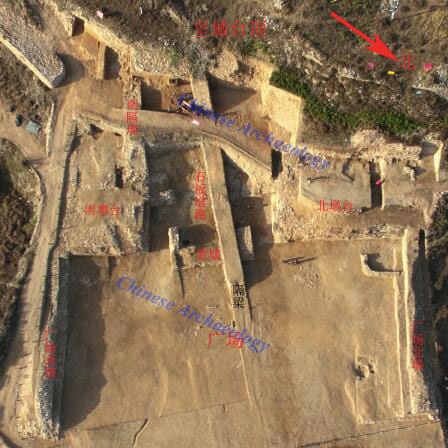Early Bronze artifact and bone tool workshops found at Shimao site, Shaanxi Province
From:Chinese Archaeology NetWriter:Date:2017-01-19
In 2016, the excavation was conducted around the gate at the Huangchengtai platform in the Shimao site. Huangchengtai is a raised platform, the three sides of which are surrounded by ditches. A narrow path leads the way from the settlement to the outside area, at the end of which the gate used to be built there. Northeast to this narrow path are located two east gates of inner and outer walled remains respectively. The platform was composed of several architectures; they were square, barbican entrance, abutment and passageway. Currently the square has been fully excavated, covering an area of over 2100 square meter.
Gate remains in Huangchengtai
The square was delimitated by two parallel walls in the north and the south respectively together with the east wall of the barbican entrance. The square was roughly rectangular in plan, with length of 63 m from north to south and width of 34 m from east to west. The surface ground was covered with yellowish brown sandy mud mixed with some small pebbles and ceramic fragments. There were traces of stepping in some areas. A stone house foundation was recovered at the center of the square.
The barbican entrance ‘wengcheng’, located between the two abutments in the square, was a stone structure having a ‘U’ shape plan. Two jade axes ‘yue’ were found located outside the wall foundation, which might have been deposited during the construction of square ground.
The two abutments were situated in the middle of the square. They were rectangular in plan. Each abutment was composed of a rammed-earth center and a stone surface and connected to northern and southern wall of the square respectively. The northern abutment was larger in size. Chronologically, the southern abutment was built as earlier as to 2200 to 2300 BC.

Bronze knife found in Huangchengtai
The doorway was located within the barbican entrance. It was delineated by the two abutments and paved with stone slabs on the ground. It gradually rose from the square upwards to the top of the abutment. Traces of polishing and stepping were recognized on stone surface.
The northwest corner of the city wall was partially unearthed. The excavated section demonstrates that the abutments supporting the wall were constructed by layers of stones. Currently the excavation has unearthed three layers of stone wall, each of them was built of stone slabs aligned in parallel. The three layers gradually expanded in size from the top towards the bottom, forming a step shape. Each of these steps was about 1m wide on which there were two lines of supporting-beam ‘renmu’ holes in parallel located at the upper and lower edges. In some holes, remains of supporting beams were still recognizable. The second step was 4m high which has been fully recovered. Beneath the supporting-beam holes, standing slabs were placed.

Jade Axe Yue in situ
Bronze artifact, stone mould, jade object and bone needle are fairly prominent assemblage types. Although stone moulds were severely damaged, two types can be tentatively recognized: multiple production and single production. Mould types include knife with a ring end, knife with a straight edge and chisel. Only the end part of the bronze knife was preserved. Judging from the remnants, the edge of the knife was fairly straight. The preservation of bronze arrowheads was much better with wings and eyes identifiable. Bronze chisels were relatively slim and preserved well. A complete “operation-chain” of bone needle production was identified from faunal remains deposited at the northwest corner at the top of the platform, including raw materials, blanks for polishing and penetrating, defective products, final products, polishing stones and so forth. There were over 250 pieces of needles found in 30 square meters soil along with about 300 pieces of chisels, spades and debris.

Orthographic Projection of Huangchengtai
Inferring from the ceramic typology, the Huangchengtai platform is approximately dated to the late Longshan period or the Erlitou period. The discovery of bronze artifacts there was listed as one of the earliest findings in China. The location of the site seemingly implies the geographical importance of the Hetao region in terms of the origin and spread of the bronze production in China. In addition, the deposition of jade outside the barbican entrance stands out from other sites, probably indicating some special social connotations. The recovery of the large amount of bone tools and the “operation-chain” of needle production suggest that a bone tool workshop might have located in the northwest at the top of the platform. The main products included chisel, awl, spade and needle, among which needles had the largest proportion. Information above will cast light upon the settlement structure and functional division of the Shimao site. This excavation of the Huangchengtai platform as a good beginning will improve our understanding of the Shimao site and its role in the trajectory towards Chinese civilization. (Translator: Dong Ningning)

